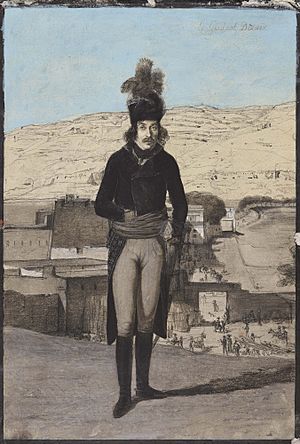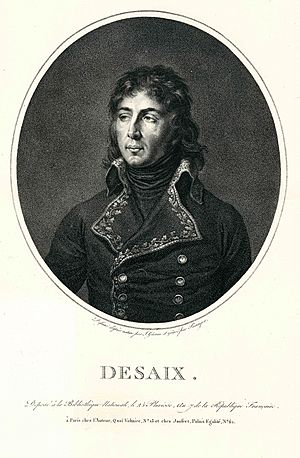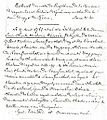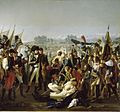Louis Desaix facts for kids
Quick facts for kids
Louis Desaix
|
|
|---|---|
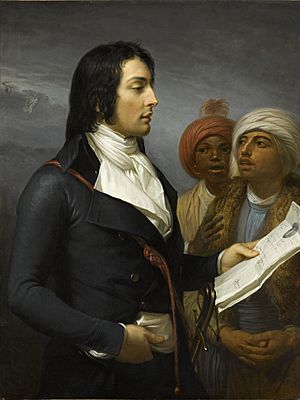
A painting of Desaix made after he died. It was based on his death mask and ordered by his helper, René Savary.
|
|
| Born | 17 August 1768 Ayat-sur-Sioule, Kingdom of France |
| Died | June 14, 1800 (aged 31) Spinetta Marengo, Italy |
| Allegiance | |
| Service/ |
Army |
| Years of service | 1783–1800 |
| Rank | General of Division |
| Battles/wars | French Revolutionary Wars |
Louis Charles Antoine Desaix (born August 17, 1768 – died June 14, 1800) was a brave French general. He was a military leader during the French Revolutionary Wars. People at the time called him Louis Charles Antoine Desaix de Veygoux. Many thought he was one of the best generals of the Revolutionary Wars.
Contents
Desaix's Early Life and Career
Desaix was born into a noble family. His family lived in the Château d'Ayat in Ayat-sur-Sioule, in a region called Auvergne. His father was Gilbert des Aix, Lord of Veygoux. His mother was Amable de Beaufranchet.
Desaix went to a military school. He joined the French royal army when he was young. For six years, he worked hard and studied military tactics.
Joining the Revolution
When the French Revolution began, Desaix strongly supported freedom. He chose not to leave France, unlike many nobles. Instead, he joined the team of Charles Louis Victor de Broglie. This choice almost cost him his life. However, he avoided the guillotine (a machine used for executions).
He quickly became popular with the new government. Like many other nobles who accepted the new ways, Desaix was a natural leader. His skills helped him rise quickly in the army. By 1794, he was in charge of a division of soldiers.
Key Battles and Campaigns
In 1795, Desaix led the right side of General Jourdan's army. The next year, he had an important role in General Moreau's attack on Bavaria.
Later, when Archduke Charles won battles at Amberg and Würzburg, Moreau's army had to retreat. Desaix bravely led the soldiers protecting the back of the army. He also defended the fortress of Kehl very well. Because of his actions, his name became famous. People spoke of him like other great generals such as Bonaparte, Jourdan, and Kléber.
In 1797, his early successes were stopped by a peace agreement. Desaix then went to Italy to meet General Bonaparte. Bonaparte was very impressed by Desaix.
Adventures in Egypt
Bonaparte soon put Desaix in charge of the "Army of England." But Desaix was quickly moved to the army going to Egypt. His soldiers faced the main attack from the Mamluk army at the Battle of the Pyramids. Desaix became even more famous for his victories against Murad Bey in Upper Egypt. The local people, called fellaheen, gave him a special name: the "Just Sultan." This meant he was a fair and good leader.
When General Kléber took command in Egypt, Desaix was one of the few chosen to go back to France with Bonaparte. It took many months for him to join Bonaparte, who was now the First Consul (a top leader of France).
Desaix was supposed to have safe passage under an agreement. However, British forces, led by George Keith Elphinstone, captured him and his troops. The British did not respect the agreement. They even pretended Desaix was just a regular soldier. Later, higher British officers ordered his release.
Desaix's Final Battle and Legacy
Desaix arrived in Italy just as the 1800 military campaign was reaching its most important point. He was immediately given command of two groups of infantry (foot soldiers).
Three days later, on June 14, Desaix was with his division near Rivalta. He heard the sounds of cannons from the Battle of Marengo nearby. He quickly decided to march his troops towards the sound. He met Bonaparte's officer, who was coming to call him back, halfway there.
Death at Marengo
Desaix and his division arrived when the Austrians were winning the battle. Desaix famously said, "There is yet time to win another battle!" He led his three groups of soldiers straight into the middle of the enemy.
At the moment of victory, Desaix was killed by a musket ball. On the very same day, his good friend and fellow general, Jean-Baptiste Kléber, was killed in Cairo, Egypt. When Napoleon Bonaparte heard about Desaix's death, he was heartbroken. He reportedly cried, "Why am I not allowed to weep?"
Remembering Desaix
Napoleon honored Desaix by building monuments for him. One was in Place Dauphine and another in the Place des Victoires in Paris. The one in Place des Victoires was later destroyed.
Desaix's body was first in Milan. In 1805, it was moved to the Great St Bernard Hospice. There, a large tomb with sculptures by Jean-Guillaume Moitte serves as his final resting place.
His name is also carved on one side of the Arc de Triomphe in Paris. This monument lists other great military leaders of the French Revolution. There is also a fort named Fort Desaix in Fort-de-France, Martinique. A street, Rue Desaix, and a small street, Square Desaix, in Paris are also named after him. Desaix Boulevard is a main street in New Orleans. Several ships of the French Navy have also been named Desaix to honor him.
Images for kids
-
A plaster cast of Desaix's bust. It was made by Angelo Pizzi, based on Desaix's death mask.
-
A statue of Desaix in Place de Jaude, in Clermont-Ferrand.
See also
 In Spanish: Louis Charles Antoine Desaix para niños
In Spanish: Louis Charles Antoine Desaix para niños


